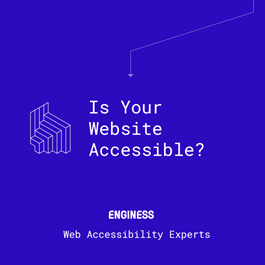
When we think of disabilities, most of us tend to think about the extremes: someone blind since birth… a quadriplegic… being completely deaf. Yet most disabilities are more subtle, more temporary, and most of us have them.
Let’s take a quick survey to see what proportion of this site’s audience suffers from a disability. Choose yes if any of these apply to you…
Beyond that, many of your visitors can be temporarily impaired in their use of the web. This happens through some very common occurrences:
-
Do you wear glasses?
-
In a wheelchair?
-
Are you deaf? Any sort of hearing impairment?
-
Taking medicine for a cold or allergies?
-
Is English not the language you first learned?
-
Left-handed?
-
Have you ever had a limb in a cast for more than two days?
-
Do you ever go to the eye doctor and leave with eye drops in?
-
Carpal tunnel syndrome?
-
ADD? ADHD? (Already bored with my list?)
-
Are you taking cold medication?
-
Are you pregnant?
-
Are you drunk?
And that’s not counting when you’re on the treadmill at the gym where five TVs are showing five stations: the sound is turned off and the captions are on, and so everyone is temporarily deaf. Or when we use a black and white laser printer to print a web page: almost all of us suffer from that temporary colour-blindness … and if you don’t design that page to work in black and white, you’ve lost your audience.
Truth is most of us have some sort of substantial disability, and we’re all temporarily disabled when we’re standing on the bus, holding a bag of groceries in one hand and trying to type on our smartphones with the other.
And so we risk losing a substantial portion of the audience we deserve when we don’t follow the inclusive design principles that are sure to leave no one behind…
1. Search engines have severe disabilities … that affect SEO
Perhaps the most frequent visitor to your website has severe disabilities. Google’s search spider (and Yahoo’s and Bing’s) is blind, deaf, and has the cognitive abilities of a five-year-old at best.
Search is getting cleverer every day. But when a spider arrives to index a website that pays no attention to accessibility, it gets a distorted or incomplete idea about that site. Without the confidence that it is perceiving how your site is organized and what’s there, you risk low rankings or content (text, photos, multimedia) that is missed entirely.
So designing for accessibility is simply good business. And this is just the first of many good reasons why every web designer should learn the rules for building accessible websites.
2. From time to time, we all have temporary disabilities
According to the U.S. Census of 2010, about 1 in 5 Americans has a substantial permanent disability:
-
8.1 million have difficulty seeing, even with glasses or contacts
-
7.6 million have trouble hearing, even with a hearing aid
-
6.7 million have difficulty grasping objects like a pencil or PC mouse
-
5.1 million have trouble concentrating on tasks
As well, around 10% of men have a colour deficit, so you can’t rely on colour to explain things to them.
And as we learned above, we all suffer from disability from time to time. So if we want everyone to get our message all of the time, inclusive design simply makes sense.
3. An accessible site helps every visitor
When we design for the extremes, everyone benefits. You may not need the cuts in the sidewalks that allow wheelchairs to cross intersections easily. But you sure enjoy them when you’re towing a suitcase or stroller.
A more accessible product benefits everyone, NOT just visitors with permanent challenges.
Following the better information design principles that are implied in the WCAG 2.0 accessibility guidelines can help all your visitors have a better experience with your site or app or distance learning application.
People are often concerned that if they follow the accessibility principles there will be a trade-off of good user experience for their mainstream users. And indeed if you don’t understand why each rule exists there is that possibility. However if you take the time to understand the thinking behind the guidelines, I promise I can show you how to implement every Level A and Level AA guideline without trade-offs … and most often with benefits for all, adding more options for entering, viewing and formatting information; removing barriers to navigation; and repairing flaws in the user experience.
In all these ways, accessible design helps build a better user experience that not only accommodates, but delights.
4. An accessible website will last longer
Very few foresaw how the iPad would transform how people use technology. And when it did, most sites that relied on Flash content for their landing pages were in trouble.
But we all know that, in this decade when the majority of humanity finally joins the internet, innovation will continue to come at an ever-increasing pace.
Accessible sites were already iPad-compatible, and the best way to inoculate the web sites of your clients and your organization against future technological change is by following device-independent standards such as WCAG 2.0. This release of WCAG will be with us for at least 10 more years, and it’s a rare hardware or software developer that releases new devices, operating systems or plug-in today without taking them into account. Those developers know how to succeed in today’s market. Now you do too.
Future-proofing alone could be your business case for websites to follow the accessibility guidelines. But there’s more…
5. Building accessible websites gives you a competitive edge
If you’re a web designer, learning to build websites that comply with accessibility rules can be a clear differentiator in the marketplace.
Again, you can help your client build a business case for accessibility. You can stress the long-term financial benefits of creating a site accessible to all. If appropriate, for some clients you can touch on the projected savings on call centres when more visitors serve themselves instead of phoning in for help. You can even mention the “stick” of possible lawsuits and the “carrot” of earning points for social responsibility.
Think about it: If you work all that in your proposal, and nobody else does, won’t that give you the inside track to win that web project?
6. Drive down costs
With a few exceptions, rigorously following the WCAG 2.0 guidelines will reduce development and maintenance costs, establishing discipline on many editorial, design, and programming phases that previously lacked them.
A typical call to a call centre costs perhaps $25 to fulfill. A self-serve help incident on a web site instead costs perhaps five cents.
More broadly, if the development team uses a more structured approach to the basics, they can spend a greater proportion of their time on the strategic issues that are more satisfying, more profitable, and result in shrewder systems that are more robust.
7. Accessibility regulations and standards are here now
If no other argument moves you, building accessible websites is becoming the law in more and more jurisdictions and situations.
The U.N. declared equal access to “information and communications technologies” a basic human right in 2006 in the [Convention on the Rights of Persons with Disabilities.]
I just completed an assignment for the World Wide Web Foundation for thewebindex.com which benchmarks, amongst other things, accessibility in 60+ countries. As I tested and reviewed government, banking, cellular, and newspaper sites in dozens of countries, I was pleased to see that the entire world is clearly converging on the same WCAG 2.0 standard. Even the United States’ government’s Section 508 regulation will soon be updated to point to WCAG 2.0, possibly as soon as June.
Governments around the world now understand the need to make the web accessible to all. At first just government, but now groundbreaking laws in Ontario are demanding a minimum level of web accessibility for private sector sites, schools, municipalities…
Some rules apply to public sector agencies, some to enterprises of a certain size. But there’s no doubt in my mind that if the previous decade was where green went from the edge to the mainstream of our societies, then the coming decade will be the one where universal, inclusive design will become how we roll. Not just because it’s the right thing to do, but because it’s simply good business.
And the convenience of the convergence on one set of standards means that it has never been easier to learn (or find the testing tools) how to make your products more accessible. The World Wide Web Consortium (W3C) produced the first Web Content Accessibility Guidelines (WCAG 1.0) in 1999. In 2008, these were updated to WCAG 2.0. (We also now have an ISO standard for accessible PDF files, called PDF/UA.)
So why wait to be pushed into it by the threat of legal action? Get ahead of the curve, and start delighting more customers and driving down costs … you may even sleep better at night.


